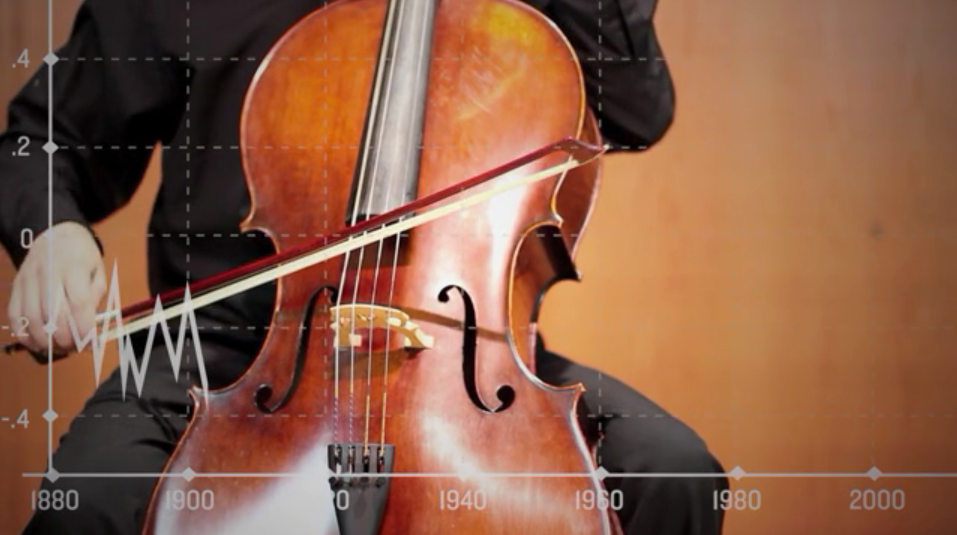This Song Is Composed From 133 Years of Climate Change Data
Daniel Crawford, a senior at the University of Minnesota, has written music for a string quartet that traces rising temperatures since the 1880s
Four nervous-looking college students pick up their bows and start into a song at the botton of their range. As the string quartet plays, the music gets higher pitched. It dips and peaks, but you can still hear it building. By the end of the song, one of the violins is struggling to hit the high notes.
Daniel Crawford, a soon to be senior geography major at the University of Minnesota, composed the song, called "Planetary Bands, Warming World," to trace the rise of Northern Hemisphere temperatures since the 1880s. Four students from the music department—Julian Maddox, Jason Shu, Alastair Witherspoon and Nigel Witherspoon—performed the song.
Each instrument plays the temperature range of a zone of the Northern Hemisphere and is tuned to the average temperature of that region. The cello tracks the equatorial zone, and the viola plays the mid-latitudes. One violin plays the high latitudes, and the other traces Arctic temperatures. Each note then corresponds to a year, and the pitch of the note represents the temperature, according to climate data from NASA’s Goddard Institute for Space Science. Higher notes are warmer years. You can hear the Earth get warmer through the music.
“We’re trying to add another tool to the toolbox,” Crawford says, “another way to communicate these ideas to the people who might get more out of this than maps, graphs or numbers.”

Trying to convey humankind's impact on the Earth through different mediums isn't new. Climate scientists have written haiku: "Big, fast carbon surge: Ice melts, oceans heat and rise. Air warms by decades." Artists have made sculptures meant to resemble fossil evidence of our existence found in rock strata millions of years from now and bright paintings made from sludge extracted from streams near coal mines. Photographers have captured aerial images of melting glaciers, deforestation and oil spills. There have even been other songs about climate change, but Crawford is the first to translate data to music.
"Planetary Bands, Warming World" is Crawford’s second climate-based composition. Two years ago, when he was interning for geography professor Scott St. George in his dendrochronology lab, he put together a similar piece, “A Song of Our Warming Planet.” St. George had asked him if he thought it was possible to turn a data set into a piece of music, and Crawford, who is a cellist, wrote a solo piece for the cello.
The new song adds another point of comparison, to show not only that the Earth is warming, but also where and by how much. “It uses all four instruments to describe the pace and the place of global warming,” Crawford says. By tracking the different climate zones separately, you can hear the contrast, and get a sense of how much temperatures have increased and what regions have warmed the most.
"The process starts with making some arbitrary decisions about what I want the end product to sound like," says Crawford. "I choose what instruments I think are appropriate, and I choose the musical range over which I want to represent the data. I use this range, coupled with the range of whatever data I'm working with, to create a key for translating each data point into a musical note."
The composer used surface data temperature from 1880 to 2015, and set the lowest recorded temperature, –0.47 °C in 1909, to the lowest note on the cello, open C. From there, the temperatures spanned three octaves and four instruments.
“Data visualizations are effective for some people, but they aren’t the best way to reach everyone,” St. George says. “Instead of giving people something to look at, Dan’s performance gives them something they can feel.”
Crawford wants to give people a window into global warming that is different than spreadsheets and Intergovernmental Panel on Climate Change reports.
"Music is an important tool because it acts to bridge the divide between logic and emotion," he says. "It is simple enough to look at numbers rise or to watch the slope of a graph increase and walk away saying 'OK, the Earth is getting warmer.' Through music, we can convey the data in a different way, which draws on the science of the numbers and also the emotional power of hearing sound."
Crawford is also trying to convey the urgency of it. Because, just like the range of temperatures that support human life, there’s a small range of temperatures that can actually be put to song this way. One day the temperatures could translate to notes so high in pitch that humans cannot hear them.
/https://tf-cmsv2-smithsonianmag-media.s3.amazonaws.com/accounts/headshot/DSC_0196_2.JPG)
/https://tf-cmsv2-smithsonianmag-media.s3.amazonaws.com/accounts/headshot/DSC_0196_2.JPG)